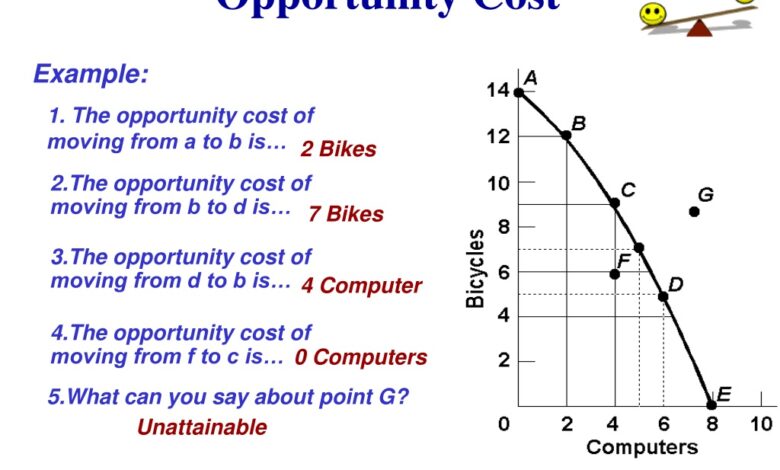
Opportunity Cost in Economics refers to the value of the next best alternative that is foregone when a decision is made. It is a fundamental concept in economics that helps individuals, businesses, and governments make informed choices by considering the benefits and costs of each decision. Understanding opportunity cost is essential for making rational decisions that maximize benefits and resources.
Breaking Down Opportunity Cost: A Basic Overview
At its core, Opportunity Cost in Economics embodies the concept of trade-offs that occur with every decision made, whether by individuals, businesses, or governments. It represents the value attached to the foregone benefits of the best alternative when a choice is made. Take, for instance, the decision to invest in stocks instead of a savings account.
- The opportunity cost would be the potential interest earnings from the savings account that you miss out on by choosing to invest in stocks. It’s the essence of what could have been—the road not taken that shapes our economic landscape. Each choice carries an inherent cost, not always measured in monetary terms but also in time, satisfaction, and other qualitative benefits. Understanding this principle is crucial for navigating the complex web of decisions we face daily, prompting a deeper evaluation of our priorities and the potential outcomes of our choices.
- By identifying and acknowledging the opportunity costs of our actions, we are better equipped to make choices that reflect our values and long-term objectives, leading to more satisfying and economically sound outcomes.
The Calculation of Opportunity Cost: A Step-by-Step Guide
To accurately determine the opportunity cost associated with a decision, one must engage in a comparative analysis of the benefits between the selected option and the next best alternative. The process begins by identifying the decision at hand and the possible alternatives to that decision. Following this identification, the critical step is to assess the value or benefits each alternative offers. This value can manifest in various forms, including monetary gain, satisfaction, time savings, or any other measurable benefit.
- The formula for calculating opportunity dating cost is straightforward yet insightful. Begin by quantifying the benefits of the option you are considering. Next, do the same for the next best alternative you are foregoing. The difference between these two values yields the opportunity cost. For instance, if opting for investment A promises a return of $100, while investment B, the next best alternative, offers a return of $80, the opportunity cost of choosing investment A over B is $20. This $20 represents the foregone benefit that could have been realized had investment B been chosen.
- It’s imperative to approach this calculation with a comprehensive understanding of the benefits involved, looking beyond mere financial gains to include other pertinent factors such as time or personal fulfillment. This holistic approach ensures a more accurate and meaningful assessment of opportunity cost, guiding decision-makers toward choices that align more closely with their objectives and values.
Opportunity Cost and Decision-Making in Everyday Life
Every day, we face a myriad of choices that directly affect our lives and the lives of those around us. These decisions, ranging from simple daily tasks to major life changes, are subtly governed by the concept of opportunity cost. Consider the decision to study for an extra hour or take that time to relax and watch your favorite show.
- The opportunity cost of studying might be the relaxation and enjoyment you forgo, while the alternative could cost you a better understanding of the subject or a higher exam score. This principle applies to both small-scale decisions and larger, more impactful ones, such as choosing between investing in further education or entering the workforce immediately.
- In navigating these decisions, the underlying question remains: What value do we place on our alternatives, and how do these values shape our choices? Recognizing the opportunity costs helps us prioritize our options based on what we value most, whether it’s career advancement, education, personal happiness, or financial security.
- By making opportunity costs an integral part of our decision-making process, we learn to choose options that not only align with our immediate desires but also support our long-term objectives and overall satisfaction. This approach empowers us to live more deliberate lives, ensuring that our decisions reflect our deepest values and aspirations.
The Impact of Opportunity Cost on Business Strategy
In the realm of business strategy, the significance of opportunity cost cannot be overstated. This concept plays a pivotal role in guiding executives and managers as they navigate through myriad investment options and strategic decisions.
- Identifying and understanding the opportunity costs associated with various business activities enable companies to better prioritize projects. Ultimately steering resources towards endeavors that offer the most substantial returns. For instance, a business might grapple with the decision of launching. A new product line or expanding into a new market.
- By evaluating the opportunity costs—what is potentially lost or gained in terms of market share, revenue, or brand positioning—companies can make strategic moves that are aligned with their overarching goals.
- Furthermore, opportunity cost analysis aids in resource allocation. It challenges businesses to scrutinize not only the financial aspects but also the allocation of human capital, time, and technological resources. This comprehensive evaluation ensures that the finite resources are devoted to projects with the highest potential impact, fostering innovation and growth. In dynamic markets, where rapid changes demand swift strategic responses, appreciating the nuances of opportunity cost becomes even more crucial. It equips businesses with the foresight to mitigate risks and capitalize on opportunities, thus maintaining their competitive advantage and driving sustainable success.
Opportunity Cost in Public Policy and Government Decisions
In the realm of public policy and government decision-making, opportunity cost plays. A crucial role in the allocation of public resources and the formulation of policies. When governments face decisions such as whether to invest in healthcare, education, infrastructure. Or defense, they must consider the opportunity costs of these choices.
- This entails evaluating what other projects or services might be sacrificed or delayed as a result. And which option would bring the greatest benefit to the public. For instance, allocating a larger portion of the budget to healthcare. May mean less funding available for education or infrastructure improvements.
- This decision-making process involves analyzing the potential impact on societal well-being. Economic growth, and the overall quality of life for citizens. By applying the concept of opportunity cost, government officials can strive for. The optimal use of limited resources, ensuring that public spending reflects the most pressing needs and priorities of the society they serve. This careful consideration helps to promote efficiency and equity in public policy. Aiming to achieve the maximum positive outcome for the community as a whole.
Common Misconceptions About Opportunity Cost
A prevalent misunderstanding about opportunity cost is its limitation to financial implications—the dollars and cents forsaken by not choosing the next best alternative. However, opportunity cost extends well beyond monetary losses or gains. It encompasses a variety of dimensions including time, personal fulfillment, effort, and even social impacts.
- For instance, the decision to pursue a higher degree might appear costly from a financial standpoint. But the opportunity cost also involves the personal and professional experiences missed during this period of study. Similarly, a business’s choice to allocate resources towards a specific project isn’t merely a financial calculation. It also involves considering the innovation, market opportunities, and employee growth that are set aside.
- This broader understanding challenges the narrow perception that opportunity cost is purely an economic. Or financial metric, highlighting its role in guiding comprehensive decision-making processes. By appreciating the multifaceted nature of opportunity cost. Individuals and organizations can better evaluate their options, considering the full spectrum of what is sacrificed and gained with each decision. This holistic approach encourages a deeper analysis of potential paths, ensuring choices are not solely. Influenced by immediate monetary benefits but are reflective of broader goals and values.
Conclusion
Opportunity cost serves as a fundamental beacon in the realm of economics, guiding us through the myriad of decisions we face daily. Its relevance stretches across various spheres of life, from personal choices to strategic business decisions and public policy considerations. By spotlighting the importance of the road not taken, it urges individuals, corporations, and government. Bodies to meticulously evaluate their options to ensure the optimal allocation of scarce resources.
Embracing this concept fosters a culture of informed decision-making. Where every choice is scrutinized for its hidden costs and the potential benefits foregone. Such an approach not only enhances economic efficiency but also enriches. The quality of decisions by incorporating a broader perspective that transcends immediate gains. As we navigate through the complexities of life, integrating opportunity cost into our decision-making toolkit. Empowers us to pursue paths that resonate most deeply with our overarching ambitions and societal needs. It is this thoughtful consideration of alternatives that paves the way for more. Fulfilling outcomes, driving progress and prosperity at both the individual and collective levels.





